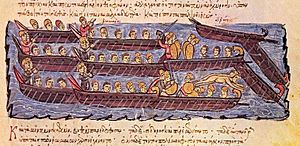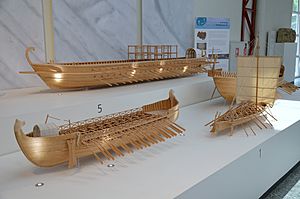Dromon facts for kids

A dromon (pronounced DRO-mon) was a special type of galley ship. It was the most important warship used by the Byzantine navy for many centuries, from the 5th to the 12th centuries AD. These powerful ships were later replaced by different types of galleys from Italy. The dromon developed from an older Roman ship called the liburnian. The liburnian was a key ship for the Roman navy during the Roman Empire.
The words dromond (in Middle English) and dromont (in Old French) came from the Greek word dromon. These words were used to describe any very large ship during the Middle Ages.
Contents
How Dromons Changed and What They Looked Like

Historians and experts still debate how medieval warships looked and changed over time. Until recently, no actual remains of an ancient or early medieval warship had been found. Information came from old writings, simple drawings, and a few remains of merchant ships.
However, from 2005 to 2006, archaeologists made an exciting discovery. During the Marmaray project in the Harbor of Theodosius (now Yenikapi) in modern-day Istanbul, they found over 36 Byzantine shipwrecks. These ships dated from the 6th to the 10th centuries. Among them were four light galleys of the galea type.
Experts generally agree on the main changes that made dromons different from older ships like the liburnians. These changes also defined later Mediterranean galleys. Dromons had a full deck across the entire ship. They also stopped using a sharp ram at the front. Instead, they had an above-water spur. Another big change was the gradual use of lateen sails.
It's not fully clear why the ram was removed. The ram was a sharp point at the front of ancient warships, used to smash into enemy ships. Some drawings from the 4th century show ships with upward-pointing beaks. This might mean the ram was already replaced by a spur on Roman galleys. Historians John Pryor and Elizabeth Jeffreys believe the spur helped the dromon ride over an enemy ship's oars. This would crush the oars, making the enemy ship unable to move.
One idea is that ships started to be built differently. Older ships had a "shell-first" construction. Rams were designed to break these hulls. Newer ships used a "skeleton-first" method, which made hulls stronger and more flexible. Rams were less effective against these new hulls. By the 7th century, people had forgotten the ram's original purpose. Some thought they were for protection against underwater rocks.
The lateen sail, a triangular sail, became very important. Some believe Arabs brought it to the Mediterranean, possibly from India. However, recent discoveries show that lateen sails were used in the Mediterranean much earlier, even in Roman times. Both triangular and square versions of these sails were used for centuries, especially on smaller boats.
Belisarius's fleet, described by Procopius of Caesarea during the Vandalic War, seemed to use lateen sails. This suggests that by the 6th century, the lateen sail was standard for dromons. The traditional square sail slowly stopped being used for medieval sailing.
These 6th-century dromons likely had one row of oars (called "monoreme"). They probably had about 50 oars, 25 on each side. Unlike older Greek ships, the oars came directly out of the hull. Later dromons, from the 9th and 10th centuries, had two rows of oars (called "bireme"). The deck separated these two rows. One row of oarsmen was below deck, and the other was above deck. The rowers on the upper deck were also expected to fight with the ship's marines during boarding attacks.
A Greek scholar named Christos Makrypoulias suggests a dromon with 120 rowers might have had 25 oarsmen below and 35 on the deck on each side. These ships were probably about 32 meters (about 105 feet) long. Most ships at the time had one mast. However, larger bireme dromons probably needed at least two masts to move well. A single lateen sail for such a large ship would have been too big to handle.
The ship was steered by two rudders at the back (the stern). The stern also had a tent that covered the captain's sleeping area. The front of the ship (the prow) had a raised forecastle. Below this, there was a siphon for shooting Greek fire. Smaller siphons could also be placed in the middle of the ship on either side. A protective barrier, called a pavesade, ran along the sides of the ship. Marines could hang their shields on it, protecting the crew on deck. Larger ships also had wooden castles on either side between the masts. These were like those used on Roman liburnians. They gave archers high places to shoot from. The bow spur was meant to ride over an enemy ship's oars, breaking them. This would leave the enemy ship helpless against attacks with missiles and boarding parties.
The four galeai ships found in the Yenikapi excavations date from the 10th to 11th centuries. They all have a similar design and construction. This suggests they were made in a central workshop. They are about 30 meters (98 feet) long. They were built from European Black Pine and Oriental plane wood.
Different Kinds of Dromons
By the 10th century, there were three main types of two-rowed warships, all part of the general dromon family. We know about them from records of expeditions against the Emirate of Crete in 911 and 949:
- The [chelandion] ousiakon: This ship was named because it had a crew of 108 men (an ousia).
- The [chelandion] pamphylon: This ship had a crew of 120 to 160 men. Its name might mean it came from the region of Pamphylia as a transport ship. Or it might mean it had "picked crews" (meaning "all tribes").
- The dromōn proper: This was the heaviest dromon. It had a crew of two ousiai, meaning even more men.
In Constantine VII's book De Ceremoniis, the heavy dromōn is said to have an even larger crew of 230 rowers and 70 marines. Naval expert John H. Pryor thinks these extra men were just passengers. Makrypoulias suggests the extra men were a second rower for each oar on the upper deck.
A smaller ship, with only one row of oars, was called the monērēs or galea. This ship had about 60 men as crew. It was used for scouting missions, but also fought on the edges of the battle line.
Some old writings from the 10th century mention dromons with three rows of oars ("trireme"). However, these writings often copied descriptions of much older Greek triremes. So, we need to be careful when applying them to Byzantine warships. Still, three-rowed ships are known to have existed in the Fatimid navy in the 11th and 12th centuries. Some mentions by Leo VI of large Arab ships in the 10th century might also refer to three-rowed galleys.
For carrying cargo, the Byzantines usually used regular merchant ships. These were mostly sailing vessels, not oared ships. The Byzantines and Arabs also used special ships to transport horses (hippagōga). These could be sailing ships or galleys. The galleys would have been changed to fit the horses. The chelandia ships were originally oared horse-transports. This suggests there were differences in how chelandion and dromōn ships were built. While the dromōn was made only for war, the chelandion would have needed a special area in the middle to hold a row of horses. This would make it wider and deeper.
Images for kids
-
Illustration from the Madrid Skylitzes showing the Byzantine fleet fighting off a Rus' attack on Constantinople in 941. Notice how the dromons used their spurs to break the oars of the enemy ships. Most naval battles in the Middle Ages involved ships getting close for hand-to-hand combat.
-
Reconstruction (top) of a dromon's hull at the Museum of Ancient Seafaring in Mainz.
See also
 In Spanish: Dromon para niños
In Spanish: Dromon para niños



